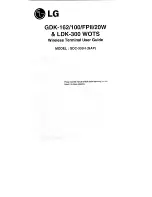
6
Tool speed is increased by increasing pressure on the
switch trigger. Release the switch trigger to stop. After
use, always press in the lock-off button from A side.
ASSEMBLY
CAUTION:
• Always be sure that the tool is switched off and the
battery cartridge is removed before carrying out any
work on the tool.
Installing or removing the saw blade
CAUTION:
• Always clean out all chips or foreign matter adhering to
the blade, blade clamp and/or slider.
Failure to do so may cause insufficient tightening of the
blade, resulting in a serious injury.
To install the saw blade, always make sure that the blade
clamp sleeve is in released position before inserting the
saw blade. If the blade clamp sleeve is in fixed position,
rotate the sleeve to the released position.
(Fig. 5)
Insert the saw blade into the blade clamp as far as it will
go. The blade clamp sleeve rotates and the saw blade is
fixed. Make sure that the saw blade cannot be extracted
even though you try to pull it out.
(Fig. 6)
NOTE:
• If you do not insert the saw blade deep enough, the
saw blade may be ejected unexpectedly during
operation. This can be extremely dangerous.
To remove the saw blade, rotate the blade clamp sleeve
in the direction of the arrow fully. The saw blade is
removed and the blade clamp sleeve is fixed at the
released position.
(Fig. 7)
NOTE:
• If you remove the saw blade without rotating the blade
clamp sleeve fully, the sleeve may not be fixed. In this
case, rotate the blade clamp sleeve fully, then make
the sleeve fixed at the released position.
OPERATION (Fig. 8)
CAUTION:
• Always press the shoe firmly against the workpiece
during operation. If the shoe is held away from the
workpiece during operation, strong vibration and/or
twisting will be produced, causing the blade to snap
dangerously.
• Always wear gloves to protect your hands from hot
flying chips when cutting metal.
• Be sure to always wear suitable eye protection which
conforms with current national standards.
• Always use a suitable coolant (cutting oil) when cutting
metal. Failure to do so will cause premature blade
wear.
• If the tool is operated continuously until the battery
cartridge has discharged, allow the tool to rest for 15
minutes before proceeding with a fresh battery.
Press the shoe firmly against the workpiece. Do not allow
the tool to bounce. Bring the blade into light contact with
the workpiece. First, make a pilot groove using a slower
speed. Then use a faster speed to continue cutting.
NOTE:
• If the tool is operated continuously until the battery
cartridge has discharged, allow the tool to rest for
15 minutes before proceeding with a fresh battery.
MAINTENANCE
CAUTION:
• Always be sure that the tool is switched off and the
battery cartridge is removed before attempting to
perform inspection or maintenance.
• Never use gasoline, benzine, thinner, alcohol or the
like. Discoloration, deformation or cracks may result.
Replacing carbon brushes (Fig. 9 & 10)
Remove and check the carbon brushes regularly.
Replace when they wear down to the limit mark. Keep the
carbon brushes clean and free to slip in the holders.
Both carbon brushes should be replaced at the same
time. Use only identical carbon brushes.
Use a screwdriver to remove the brush holder caps.
Take out the worn carbon brushes, insert the new ones
and secure the brush holder caps.
To maintain product SAFETY and RELIABILITY, repairs,
any other maintenance or adjustment should be
performed by Makita Authorized Service Centers, always
using Makita replacement parts.
OPTIONAL ACCESSORIES
CAUTION:
• These accessories or attachments are recommended
for use with your Makita tool specified in this manual.
The use of any other accessories or attachments might
present a risk of injury to persons. Only use accessory
or attachment for its stated purpose.
If you need any assistance for more details regarding
these accessories, ask your local Makita Service Center.
• Recipro saw blades
• Various type of Makita genuine batteries and chargers
• Plastic carrying case
NOTE:
• Some items in the list may be included in the tool
package as standard accessories. They may differ
from country to country.
Noise
ENG905-1
The typical A-weighted noise level determined according
to EN60745:
Sound pressure level (L
pA
): 83 dB (A)
Sound power level (L
WA
): 94 dB (A)
Uncertainty (K): 3 dB (A)
Wear ear protection.
Vibration
ENG900-1
The vibration total value (tri-axial vector sum) determined
according to EN60745:
Work mode: cutting boards
Vibration emission (a
h,CW
): 16 m/s
2
Uncertainty (K): 1.5 m/s
2
ENG901-1
• The declared vibration emission value has been
measured in accordance with the standard test method
and may be used for comparing one tool with another.







































